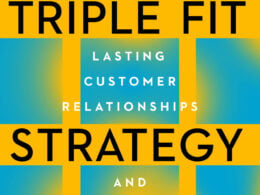The following is excerpted from “Choose Your Customer: How to Compete Against the Digital Giants and Thrive” by Jonathan L.S. Byrnes and John S. Wass, pp. 141-145 (McGraw Hill, May 2021).
You are what you sell.
Your customers are the front-wheel drive that pulls you through your marketplace. All too many companies today implicitly assume that their objective is to maximize their sales revenue, and they make the subsidiary assumption that they can minimize their costs through ancillary processes, and thus maximize their net profits.
This set of management assumptions is completely wrong. It is an obsolete holdover from the vanishing age of mass markets. Today, the core management objective is to maximize your profitable growth in your chosen market segments.
StartupNation exclusive discounts and savings on Dell products and accessories: Learn more here
Building dominance in your chosen market segments
Consider Custom Research, a small but successful market research firm.
Custom Research had a problem. The company had grown from a relatively small startup over the course of several years into one of the larger, well-respected companies in its business.
Over time, however, the company’s financial performance had eroded. After a number of years of high growth, the company’s return on sales (net profit as a percent of revenues) was steadily dropping, and sales had slowed. When management looked closely at the company’s situation, most clients were “profit desert” clients, with only a few small and marginally profitable projects each year.
The company’s strategy was essentially to take all clients that it could land, under the assumption that each would contribute to overhead and that the company needed a significant market share to be a “player.”
The problem, however, was that the industry was consolidating, and the surviving firms were becoming relatively large and aggressive. In that context, Custom Research found its profit growth slowing substantially despite having a significant market share and lots of clients. The company was running out of resources, and it was essentially “stuck in the mud.”
The action questions were these:
- What happened? and,
- What should they do?
In today’s age of diverse markets, company after company across a wide range of industries is facing these same two essential questions.
The underlying problem was that Custom Research was so focused on growth at all costs that it neglected to build a sound account selection and management process that would produce not just growth, but profitable growth.
Custom Research was becoming flooded with numerous low-potential, high-maintenance customers that were taking increasing amounts of the producing partners’ mindshare, time and resources. These accounts were crowding out the partners’ ability to focus on deepening their penetration of their lucrative high-potential profit peak clients. Worse, the firm’s increasingly scattered portfolio was endangering its partners’ ability to produce high-quality work for its premier clients, and it was diluting its strategic differentiation — a deadly combination.
Related: Why Startups Fail: A Harvard Business School Professor’s Letter to a First-Time Founder
The company’s indiscriminate account selection situation almost eliminated the opportunity to create and implement an effective account management process (that is, managing the client’s buying process to deepen its relationship) with the right clients.
The way out of this type of dilemma is to clarify and enforce an effective, practical set of account qualification criteria.
In Custom Research’s case, this included factors such as these:
- Revenue potential
- Net profit potential
- Strategic and operating fit
- Willingness and ability to partner (versus transactional buyer behavior)
- Likelihood of closing
These account qualification criteria would bring in the most profitable business — which left the important residual problem of how to manage down the current profit desert client population. The way that Customer Research’s managers thought about their situation was that in the past, their goal was to maximize market share, but now they needed to maximize their profit.
Your real goal is to maximize your market share of the most inherently lucrative, high-potential portion of the market — your profit peaks, and those that should be in this group — both in your current industry paradigm and in your transformed industry. The key to success is understanding that there is not a trade-off between high growth and high profits, and in fact they reinforce each other if you utilize transaction-based profit metrics and analytics, along with effective profit management processes.
After analyzing its problem, Custom Research’s management team decided to end the practice of taking every client that requested a project. The firm would not work with clients with annual business of less than a set amount, and it would begin to focus on building the larger profit peak client relationships.
In deciding to stop taking all business that was available, Custom Research achieved two important goals:
- First, the business it did take was more profitable, producing more net profits per project; and
- Second, the company’s staff was freed up to better manage their high-profit and high-potential accounts by providing the best possible service, building their customer value footprint.
In a second step, a few years later, management decided to double the minimum set amount and take only those clients with the potential to grow to two to three times the minimum amount within a few years.
The results: Custom Research reduced its client count by about 50%, sales rose by about 60%, profits more than tripled, and the company’s return on sales rose from 9 to 20%.
Account selection — choosing your customer — is a critically important process that you can structure and manage in a very systematic way that maximizes your sales resource productivity.
Choosing your customers means two things:
- Identifying and obtaining those customers who are and will be profit peaks, and
- Avoiding the prospects who will not become profit peaks.
The second point is particularly important, and this is where most companies fail both because they do not have a clear understanding of their profit peak customers’ profile, and because they do not have a clear set of processes (including compensation) to avoid selling to prospective customers that are unlikely to develop into profit peaks.
Sign Up: Receive the StartupNation newsletter!
Digital giants have certain overwhelming advantages. Few companies can match these strengths in a head-to-head contest. The bottom-line message is that most companies have plenty of opportunities to stake out a very lucrative strategic high ground in the remaining segments of the markets — if they have the discipline and processes to focus their resources on this objective.
“Choose Your Customer: How to Compete Against the Digital Giants and Thrive” is available now and can be purchased via StartupNation.com.






